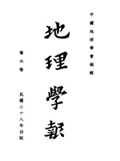NING CHIEN, WEN-HAO ZHOU AND ROU-JIA HONG
Lower Yellow River in Honan Province is characterized by a wide and shallow bed choked with sand bars. The stream is deflected in all directions into such a spread-0ut and intricately subdivided cross-section that no meanders developed. The river flows in a number of branching and reuniting streamlets with one of them as the main channel. This main river course ever shifts its position at an average speed of 10-300 m./day during floods. A shifting of the river course with as much as several kilometers is often recorded after the passage of a large flood, and the channel can be completely reverted its position from one bank to the other. Three basic types of the channel shifting can be distinguished. The main flow often captures another river fork and fills the old channel with sediments. In areas where no branchine of than-nel exists, the flow direction is sometimes changed either by the movement of the sand banks or by bank-savings. These local adjustments of bank lines are often associated with changes in river discharge. In certain cases the shifting of the flow is a consequence of the changes in flow pattern upstream. In other words, whenever the flow direction changes, its influence will be propagated downstream. The braided stream of the Lower Yellow River is separated intermittently by a sequence of wide- and narrow-reaches. Whenever the flow pattern varies, its effect will be felt much less do-wnstream of a narrow reach. These reaches are, therefore, called the primary control points of the river. They manifest their full effects when the river flows in full width in that area. As the river overflows the flood-plain, or as the stage is so low that central bars appear, the regulating effect of the control points is also weakened. At low flows, a number of secondary control points along the river course is noted. They are located along high shores or river regulating works on one side, and low sand banks on the other. The flow takes a curved path in that region and the con- cave side is coincided with the fixed bank line. As the sand banks are movable, the secondary control points are not fixed in position, in contrast with the primary control points. They are comparatively more stable in low-flow seasons, and can be easily destroyed after the passage of a larger flood. Both the primary and the secondary control points play a dominating role in the fluvial processes of the Lower Yellow River, and should be relied on as the basis for regulating the channel in the future. The formation of the braided stream of the Lower Yellow River depends primarily on the hydrographic and geologic conditions of the Yellow River Basin. The Yellow River watershed distinguishes itself by the following aspects: (1) an enormously large amount of sedimentary particles is produced by the basin and filled the channel with fine sediment; (2) the alluvial deposits along the river course are not homogeneous, with fine sand and silt in Honan Province and more clay deposits in Shantung Province; (3) the sediment, once deposited, can be easily put into motion again by the flow which moves rather rapidly along a comparatively steep slope; (4) the flood rises and subsides abruptly with a prominent peak; (5) the variation of discharge is large; and (6) the sediment concentration varies widely at same discharge. Among these conditions, the aggradation of the channel and the lack of lateral control are the basic factors which induce the development of the braided channel pattern in Honan Province. Other factors are more respon- sible in setting up the high frequency and large amplitude of the channel shifting.
